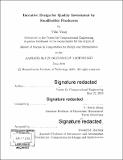| dc.contributor.advisor | Y. Karen Zheng. | en_US |
| dc.contributor.author | Yang, Yilin,S.M.Massachusetts Institute of Technology. | en_US |
| dc.contributor.other | Massachusetts Institute of Technology. Computation for Design and Optimization Program. | en_US |
| dc.date.accessioned | 2019-10-11T22:00:20Z | |
| dc.date.available | 2019-10-11T22:00:20Z | |
| dc.date.copyright | 2019 | en_US |
| dc.date.issued | 2019 | en_US |
| dc.identifier.uri | https://hdl.handle.net/1721.1/122526 | |
| dc.description | Thesis: S.M., Massachusetts Institute of Technology, Computation for Design and Optimization Program, 2019 | en_US |
| dc.description | Cataloged from PDF version of thesis. | en_US |
| dc.description | Includes bibliographical references (pages 83-85). | en_US |
| dc.description.abstract | The food safety problem has been challenging the traditional operating model of Chinese agricultural supply chain. In the recent decades, more and more agribusinesses and cooperatives in China have adopted contract farming to strengthen food safety control during the sourcing process. Meanwhile, several pricing schemes are applied to incentivize the quality-improving effort from producers of different risk attitudes and defaulting likelihoods. In this paper, we consider a producer-agribusiness supply chain with stochastic wholesale market price and random production yield. We model the three commonly-observed pricing schemes of contract farming in China: 1. Markup contract, 2. Fixed-price contract and 3. Protective-price contract. We characterize the equilibrium of the contracting game under each pricing scheme with risk-neutral and/or risk-averse producer. Furthermore, we investigate the optimal contract selections under different producer characteristics. We find that compared to the most frequently-used markup contract, the fixed-price and protective-price contract better incentivize the risk-averse producer to exert higher levels of quality-improving effort; In addition, switching from a markup contract to a protective-price contract or a fixed-price contract (under a certain threshold of defaulting rate) will achieve a win-win outcome where both the expected profit of the company and the utility of the risk-averse producer increase. Finally, we offer insights on the selection between the protective-price contract and fixed-price contract under different market price and production yield conditions. | en_US |
| dc.description.statementofresponsibility | by Yilin Yang. | en_US |
| dc.format.extent | 85 pages | en_US |
| dc.language.iso | eng | en_US |
| dc.publisher | Massachusetts Institute of Technology | en_US |
| dc.rights | MIT theses are protected by copyright. They may be viewed, downloaded, or printed from this source but further reproduction or distribution in any format is prohibited without written permission. | en_US |
| dc.rights.uri | http://dspace.mit.edu/handle/1721.1/7582 | en_US |
| dc.subject | Computation for Design and Optimization Program. | en_US |
| dc.title | Incentive design for quality investment by smallholder producers | en_US |
| dc.type | Thesis | en_US |
| dc.description.degree | S.M. | en_US |
| dc.contributor.department | Massachusetts Institute of Technology. Computation for Design and Optimization Program | en_US |
| dc.identifier.oclc | 1121593882 | en_US |
| dc.description.collection | S.M. Massachusetts Institute of Technology, Computation for Design and Optimization Program | en_US |
| dspace.imported | 2019-10-11T22:00:18Z | en_US |
| mit.thesis.degree | Master | en_US |
| mit.thesis.department | CDO | en_US |
